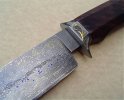Hi everyone,
Just checked this thread again recently. Thanks for those who replied to my post with such flattering compliments (too flattering for a young amateur student of swords). I really ought to proofread my posts a bit more carefully, though - I think I used the word "beautiful" 100 times too many.

Also, allow me to say that of everything I have enthusiastically studied during the time I have been interested in swords, wootz is pretty low down on the list. I don't want anyone to think that my word on any of this is definitive - I'm just relating the nature of things as I have come to understand them through my (very amateur) studies. For instance, as far as I know, the layering pattern in wootz blades was apparently caused by carbides segregating themselves due to the interesting effects of alloying elements such as Vanadium - but I have also seen evidence of deliberately induced patterns, so I'm not exactly sure of the forging process. Then again, wootz in general was kind of mysticized and enigmatic and remains one of the least comprehensively understood materials to this day - so maybe my uncertaintly is justified.

Also, my opening comments regarding "damascus" steel sounded fairly harsh in retrospect - and although I believe I adequately expressed my views on the subject by the end of that post, allow me to reiterate that some damascus I really, really like.

Funny thing about the term "damascus..." It basically doesn't mean anything directly. Today it's used to describe pattern-welded blades (a distinctly migration-era European technology, although it has examples from many cultures and time periods). Originally it described wootz blades obtained from trade with the Middle East -through the trading city of Damascus. Yet wootz technology did not originate in Damascus, nor was Damascus a center of swordsmithing in and of itself - the technique is an Indo-Persian one. Not only this, but famed "Toledo" steel gained its fame *in part* from the occupation of that Spanish city - meaning that it was respected for blades whose construction methods originated as far away as India. Crazy, no?
Ach, there I go again. I apologize if you've all heard these before - it's just that coming from a interest in historical research to a forum widely concerned with modern knives leaves me eager to share some of the more interesting anecdotes pertaining to swordcraft. Please feel free to stop me if I'm preaching to the choir here, as I am sure I will be to some (many?) of you.
And I still need a dang pocket folder...



